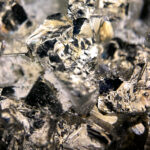The periodic table, an iconic arrangement of chemical elements, has long been a cornerstone of the study of chemistry. Comprising over 118 elements, it serves as a roadmap for understanding the properties and relationships of these fundamental building blocks of matter. However, the question of whether brass belongs on the periodic table is not as straightforward as it might seem. Brass, a widely used material known for its golden appearance, is not an element but rather an alloy. This article delves into the world of alloys, explores the chemistry behind brass, and discusses the criteria for inclusion on the periodic table. We will also explore the role of alloys in the broader context of chemistry and materials science.

What Is Brass?
Before we delve into the question of whether brass belongs on the periodic table, it is crucial to understand what brass is and why it is not considered an element.
Alloys: The Blend of Elements
An alloy is a mixture of two or more elements, at least one of which is a metal. These elements are combined to create a substance with properties that are distinct from those of the individual components. Alloys are designed to take advantage of the desirable characteristics of their constituent elements while mitigating their weaknesses. Brass is a classic example of an alloy, consisting primarily of copper (Cu) and zinc (Zn) in various proportions, typically around 70-80% copper and 20-30% zinc.
The Chemistry of Brass
Brass is a fascinating material with a rich history and a range of applications, from musical instruments to decorative elements and engineering components. Understanding the chemistry behind brass is vital in appreciating why it is not included in the periodic table.
Copper: The Primary Component
Copper, a ductile and highly conductive metal, is the primary component of brass. It is found in group 11 and period 4 of the periodic table, with the atomic number 29. Copper’s distinctive reddish-brown color is well-known, and it has been used for thousands of years due to its malleability, electrical conductivity, and corrosion resistance.
Zinc: The Alloying Element
Zinc, on the other hand, is a bluish-white metal that falls under group 12, period 4 of the periodic table, with the atomic number 30. When combined with copper, zinc imparts unique properties to the resulting alloy. For instance, it enhances brass’s hardness and corrosion resistance. The proportion of zinc in the alloy can be adjusted to fine-tune these properties, resulting in different types of brass.
Criteria for Inclusion on the Periodic Table
The periodic table is a systematic arrangement of elements based on their atomic number, which reflects the number of protons in an atom’s nucleus. Elements are organized in rows and columns according to their atomic structure and properties. This raises the question: why isn’t brass, or other alloys for that matter, included on the periodic table?
Elements vs. Compounds and Alloys
The periodic table exclusively features elements, which are substances composed of a single type of atom. These atoms all have the same number of protons, giving them unique properties. In contrast, compounds and alloys consist of multiple types of atoms or elements combined in various ways.
Periodic Table as a Framework for Understanding Elements
The periodic table’s primary purpose is to provide a structured framework for understanding the behavior and properties of individual elements. Each element is unique, characterized by its atomic number, electron configuration, and distinct set of properties. This classification system allows scientists to predict how elements will react and form chemical compounds.
Alloys: A Unique Challenge
Alloys like brass introduce an interesting challenge to the periodic table’s strict framework. While they are indeed composed of elements, the mixing of elements in alloys leads to compounds with varying properties. Brass can be created in different compositions, resulting in a range of properties and applications. These variations make it impractical to place alloys directly on the periodic table, as they do not have a fixed atomic number, electron configuration, or consistent properties.
Historical Context: The Development of the Periodic Table
Understanding why brass is not on the periodic table also involves considering the historical development of this fundamental tool in chemistry.
Dmitri Mendeleev’s Periodic Table
Dmitri Mendeleev, a Russian chemist, is credited with the creation of the first periodic table in 1869. Mendeleev’s table arranged elements by atomic weight, which allowed him to predict the existence of yet-to-be-discovered elements and their properties. This arrangement was groundbreaking in its time and has evolved over the years to become the modern periodic table.
The Evolution of the Periodic Table
The periodic table has evolved from its early form based on atomic weight to the contemporary version that arranges elements by increasing atomic number. This modification was made to account for discrepancies in Mendeleev’s initial arrangement and better represent the periodicity of elemental properties. The current table categorizes elements into groups and periods, allowing for a more accurate depiction of their behavior and characteristics.
Incorporating Alloys into the Periodic Table: A Dilemma
As discussed earlier, alloys like brass are not straightforward additions to the periodic table due to their composition-dependent properties. While it might be feasible to include a specific brass composition, the table would become overwhelmingly complex when considering the multitude of possible alloy combinations, each with varying proportions and properties.
The Role of Alloys in Materials Science and Engineering
While brass may not have a place on the periodic table, alloys, in general, hold a significant place in the fields of materials science and engineering. Let’s explore the importance of alloys in these areas.
Alloys: Tailoring Properties for Specific Applications
Alloys are prized in materials science for their ability to combine the strengths of different metals while mitigating their weaknesses. For example, steel, an alloy of iron and carbon, is celebrated for its exceptional strength, durability, and corrosion resistance. By adjusting the alloying elements, materials scientists can design alloys that meet the specific requirements of diverse applications, from aerospace components to biomedical implants.
The Alloying Process
The creation of alloys involves the careful mixing of elements and compounds, often accompanied by heat treatment. This process ensures that the atoms of different elements are uniformly distributed throughout the material, resulting in the desired properties. For instance, in the case of brass, the addition of zinc to copper significantly enhances its hardness and corrosion resistance.
Applications of Brass
Brass, as an alloy of copper and zinc, has numerous applications across various industries. These include:
- Musical Instruments: Brass instruments like trumpets and trombones are renowned for their distinctive sound and are made from a specific brass composition designed to achieve the desired acoustic properties.
- Decorative Elements: Brass is a popular choice for decorative items due to its pleasing appearance and resistance to tarnish. It is often used in sculptures, ornaments, and architectural details.
- Plumbing and Fittings: Brass fittings and plumbing components are valued for their corrosion resistance, making them ideal for use in water-related applications.
- Automotive Parts: Brass is used in various automotive components, including radiators and connectors, where its thermal conductivity and corrosion resistance are advantageous.
- Ammunition Casings: Brass is used for shell casings in ammunition due to its strength and ability to expand and seal the chamber when fired.
Conclusion
Brass is indeed not found on the periodic table because it is an alloy, a mixture of copper and zinc in varying proportions. The periodic table is reserved for individual elements, each defined by a unique atomic number, electron configuration, and set of properties. While alloys like brass have their own significance in materials science and engineering, their composition-dependent properties and the vast number of possible variations make their inclusion on the periodic table impractical.
Understanding the distinction between elements and alloys is fundamental to comprehending the role of the periodic table as a tool for organizing the elements that constitute matter. The periodic table remains a cornerstone of chemistry, guiding scientists in their quest to unlock the secrets of the natural world. In contrast, alloys like brass serve as a testament to humanity’s ability to engineer and manipulate materials to suit a wide range of practical applications.





